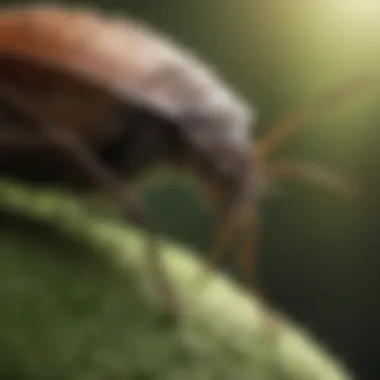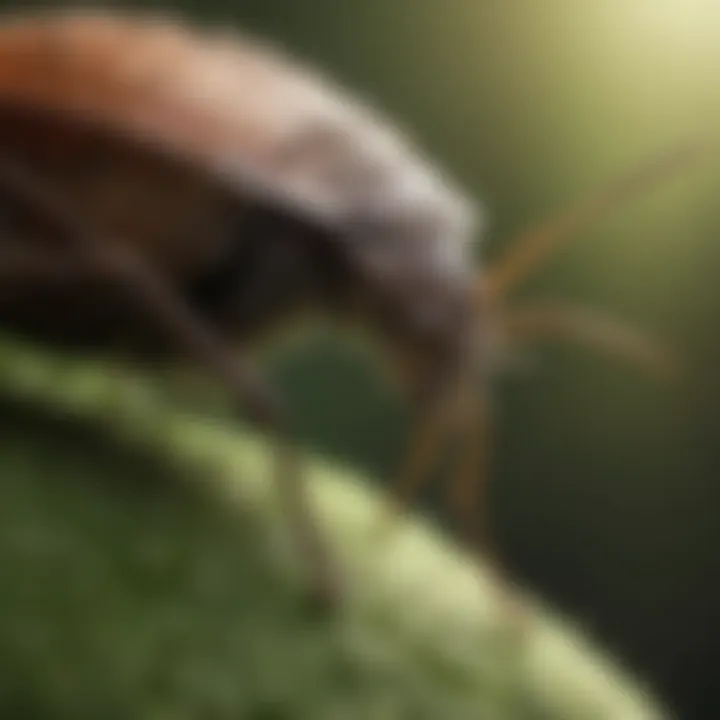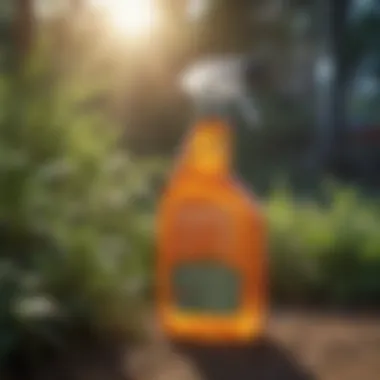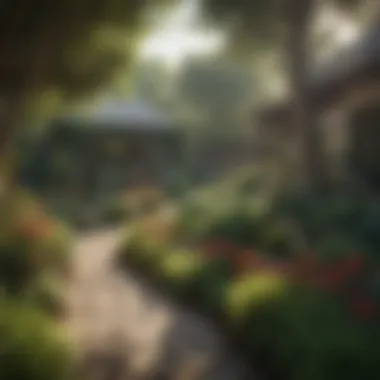Strategies to Control Outdoor Stink Bug Populations


Intro
Stink bugs, those little brown intruders, have a knack for making their presence felt in our gardens and yards. Homeowners often find these pests not just annoying, but also a nuisance that can disrupt the tranquility of outdoor living spaces. This article shines a light on tackling the issue of stink bugs outside residential properties, arming you with effective strategies that blend practicality with environmental awareness. We'll dive into various methods that can help you keep these pests at bay while ensuring that our ecological balance remains intact.
Understanding Pests
It's essential to grasp what we are dealing with. Stink bugs belong to a family of pests that often invade gardens, and knowing the specifics about them can empower homeowners.
Definition of Pests
Pests are organisms that cause harm to crops, ornamental plants, or residential areas. Stink bugs fit this description well, notoriously feeding on fruits, vegetables, and decorative plants. Their ability to reproduce quickly creates a significant challenge, especially during the warmer months when their population can explode.
Importance of Pest Identification
Identifying stink bugs is the cornerstone of managing their numbers effectively. A stink bug’s appearance—a brownish, shield-shaped body with distinctive white markings—can be a telltale sign. By training your eyes, you can quickly differentiate these pests from beneficial insects. This knowledge not only mitigates panic but allows for targeted action steps.
Prevention Techniques
Outsmarting stink bugs requires proactive measures. Prevention can often save you from dealing with a more significant infestation later on.
Home and Garden Preventative Measures
- Seal Entry Points: Examine your home for cracks and gaps that might let stink bugs slip in. Caulking windows and doors is a straightforward fix.
- Manage Outside Lighting: Outdoor lights can attract stink bugs. Use yellow bulbs that are less appealing to them.
- Maintain Your Garden: Keep plants healthy and free from disease, and avoid overwatering, which may encourage pest habitats.
- Regular Cleaning: Keep yards tidy by removing debris and fallen fruit, which can attract stink bugs.
Seasonal Prevention Tips
In the spring, ensure that any remaining debris from winter is cleared away. Additionally, consider planting carrot or radish, which stink bugs tend to favor less than other plants. As summer approaches, monitor your garden closely, as this is when they will be most active. Preparing in advance can yield significant long-term benefits.
Eco-Friendly Pest Control Solutions
While prevention is critical, sometimes you must take action to eliminate these intruders. Thankfully, there’s a myriad of eco-friendly strategies available.
Overview of Sustainable Practices
Sustainable pest control emphasizes using natural solutions that minimize environmental impact. This approach can involve understanding natural predator-prey relationships or using biocontrol methods, such as introducing beneficial insects that naturally manage stink bug populations.
Natural Remedies and Their Effectiveness
Natural remedies can prove quite useful in your battle against stink bugs. Here’s a quick rundown:
- Soap and Water Spray: A simple mixture sprayed directly onto stink bugs can suffocate them without harsh chemicals.
- Neem Oil: This oil disrupts their growth and reproduction, making it an effective deterrent when sprayed consistently on plants.
- Garlic Spray: A mixture of garlic and water can repel many insects, including stink bugs.
In summary, understanding stink bugs and their habits is vital in preventing and controlling their populations effectively. Using practical prevention techniques and eco-friendly remedies not only tackles the problem but also respects the natural environment. Armed with this knowledge, homeowners can navigate the challenges posed by stink bugs and enjoy their outdoor spaces to the fullest.
Understanding Stink Bugs
Grasping the intricacies of stink bugs is paramount for homeowners who want to fend off these pesky intruders. These critters, while part of nature, can wreak havoc on gardens and invade homes, causing both annoyance and damage. Understanding their characteristics, habitat preferences, and behaviors lays the groundwork for effective control measures. This section will illuminate the essentials about stink bugs, ensuring you're better prepared to manage them.
Identification of Stink Bugs
Recognizing a stink bug is the first step in combating them. With a somewhat shield-like body, these bugs often measure about half an inch in length, but some can grow larger. Their coloration varies, typically displaying shades of green or brown, but they can camouflage themselves surprisingly well among foliage. Notably, their bodies feature distinct, mottled patterns that can make them a challenge to identify at a glance.
Inspecting the shape of their bodies can help too. The typical stink bug sports a noticeable triangle or "V" shape on its back, and often, they emit a foul odor when threatened, which can be an indicator of their presence. Once you’re familiar with these physical traits, you’ll be better equipped to spot them on your property, especially during the warmer months when they are most active.
Origins and Habitat
Stink bugs are native to various regions, but the Brown Marmorated Stink Bug, which has become common in the United States, hails from Asia. Understanding their journey can provide meaningful insights into controlling their populations. These bugs typically thrive in agricultural areas where they feed on fruits and vegetables. They prefer warm environments, often seen in gardens, fields, and orchards during summer.
During colder months, stink bugs seek refuge indoors or in sheltered outdoor spots, making homes and garages their chosen harbors. To effectively reduce their numbers, it’s crucial to know where they’re likely to linger. Keeping your gardens well-trimmed and devoid of clutter—such as wood piles or dense leaf litter—can deter them from settling nearby.
Behavioral Patterns
Understanding stink bug behavior can significantly enhance your efforts in managing them. They are primarily active during the warmer hours of the day, particularly in sunshine. Stink bugs are herbivorous and primarily feast on plants, which is why they gravitate toward gardens and cultivated areas.
They’re also known to congregate in large numbers, especially during their breeding season. During late summer and early fall, you might notice them swarming around windows or doors, seeking warmth as temperatures drop. Observing their patterns can help in identifying high-risk times for infestations, allowing for preemptive measures.
By recognizing their habits, you can devise proactive strategies that keep your outdoor spaces less appealing to these unwelcome guests.
By thoroughly exploring these facets of stink bugs, homeowners can arm themselves with valuable knowledge, allowing for effective strategies to keep these pests at bay. With a solid foundation of understanding, you’ll be well-prepared to take the next steps in managing stink bugs effectively.
Why Stink Bugs Enter Your Property
Understanding the reasons why stink bugs invade your spaces is key to effectively managing their populations. These pests can be more than just a nuisance; they threaten gardens, crops, and even the structural integrity of your home if left unchecked. Knowing their motivations can help homeowners take preventative measures to keep them at bay.


Seasonal Influences
As seasons change, so do the behaviors of stink bugs. Typically, these critters become more active during the warmer months when food sources are plentiful, such as fruits and vegetables. However, as autumn rolls around, their instinct to seek shelter grows stronger, driving them indoors. This seasonal change highlights the importance of timing in your pest management strategy. By recognizing their patterns, like when they’re likely to invade your space, you can take proactive steps to secure your home.
In places like urban areas, where green spaces are limited, stink bugs may not need to travel far when looking for warmth and protection during chilly months. This is especially true if neighboring homes create inviting environments for them too.
Attractive Landscaping
The way you design and maintain your outdoor space can dramatically influence whether stink bugs choose your property as a haven. Certain plants can lure these bugs in like moths to a flame. For instance, if you have crops such as peppers, tomatoes, or fruit trees, expect an uptick in stink bug traffic as they are drawn to these food sources. Utilizing a diverse range of plants can create a more balanced ecosystem, but unwittingly, you might be inviting unwelcome guests by planting particular varieties that stink bugs prefer.
To mitigate this, consider selecting varieties that are less appealing to stink bugs. This might include more pest-resistant plants or flowers that don’t attract them. Being mindful of how your yard can contribute to, or ease, the stink bug situation is crucial.
Structural Vulnerabilities
Homes, much like individuals, have their own vulnerabilities. Stink bugs are notorious for exploiting small cracks and crevices around windows, doors, and foundations that homeowners often overlook. This means that even a seemingly minor gap can become an invitation for these pests. Regularly inspecting the exterior of your home for potential entry points can make a substantial difference in keeping them out. Simple measures like caulking gaps, installing screens, and ensuring your doors seal tightly shut can thwart these intruders.
In addition to physical barriers, consider the materials you use around your property. For example, wooden structures or mulch can provide hiding places for stink bugs. Making conscious choices about landscaping materials can prevent them from making themselves at home.
"Managing stink bugs starts with understanding the reasons they invade in the first place. Once you grasp their motives, you're halfway to taking action."
Stink bugs might be small, but their presence can be pervasive. Understanding why they come to your property is fundamental in designing effective prevention strategies. By considering seasonal factors, landscaping choices, and structural weaknesses, you can significantly enhance your defense against these unwanted guests.
Preventive Measures for Stink Bug Control
Taking preventive measures against stink bugs is crucial for every homeowner concerned about the pests infiltrating their outdoor spaces and eventually their homes. By being proactive rather than reactive, one can save time, money, and the stress that comes with the hitchhiking nature of these bugs. Stink bugs are persistent and can wreak havoc when they decide to set up camp in your garden or, worse, your living room. Therefore, understanding how to keep them at bay is essential for maintaining a peaceful environment around your home.
Seal Entry Points
One of the first lines of defense in stink bug control is ensuring that all potential entry points into your home are sealed tight. Stink bugs are small, yet they have an uncanny ability to find even the tiniest cracks and crevices. This includes gaps around windows, doors, siding, and any other openings. To begin, visually inspect your home for any cracks and leaks.
A good sealing strategy might include:
- Using caulk for cracks that can be easily filled.
- Installing door sweeps on exterior doors.
- Screening vents and chimneys.
- Repairing damaged weather stripping on windows and doors.
Addressing these areas not only helps in preventing stink bugs but enhances the overall energy efficiency of your home as well. The bottom line is that a little effort in sealing up can go a long way in staving off an invasion.
Yard Maintenance Practices
The yard itself can be an inviting haven for stink bugs if not properly maintained. Regular yard work is more than just aesthetics; it prevents these pests from feeling welcome right outside your door. Start by eliminating overgrown vegetation, as these plants can often provide shelter and a food source. Here are some yard maintenance tips:
- Mow the lawn regularly to keep it trimmed and tidy.
- Remove debris like leaves and any old crop residue which might attract the bugs.
- Keep mulch to a minimum around your plants to avoid a cozy resting spot for stink bugs.
- Clear away any standing water where they might congregate.
By implementing these practices, you significantly reduce the likelihood of stink bugs making your yard their home base.
Plant Selection
Did you know that the type of plants in your garden can either attract or deter stink bugs? Certain varieties seem to allure these pests like moths to a flame. The strategy here revolves around planting species that are less favorable to stink bugs and opting for plants that repel them instead.
Some repellent plants include:
- Lavender: Known for its pleasant fragrance, it also keeps many pests at bay.
- Marigold: These flowers not only beautify your space but can also deter bugs.
- Basil: A fragrant herb that’s dual-purpose in both cooking and pest control.
On the other hand, it's wise to avoid plants that are known to attract them, such as certain fruit trees and specific vegetables. Therefore, discerning plant choices can create a natural barrier that benefits both your garden and your peace of mind.
"An ounce of prevention is worth a pound of cure." By integrating these preventive measures, you position yourself ahead of the game against unwanted stink bugs, ensuring a more enjoyable outdoor experience.
Natural Repellents for Stink Bugs
Natural repellents offer a distinct advantage in managing stink bug populations. Not only do they present eco-friendly solutions, but they also help keep your outdoor space safe for children and pets. Utilizing substances found in nature is not only safer but often more effective in deterring stink bugs compared to harsh chemicals. Here, we will explore how certain natural repellents can significantly reduce these pests in your garden or yard, while also taking into account the benefits and considerations that come with their use.
Essential Oils
Essential oils have garnered much attention for their pest-repelling properties, and stink bugs are no exception. Certain oils, such as peppermint, eucalyptus, and cedarwood, can work wonders against these critters. The aromatic compounds in these oils are off-putting to stink bugs, serving as a preventative measure against infestations.
- Peppermint Oil: Its strong scent is particularly potent. Mix a tablespoon of this oil with water in a spray bottle to create an effective repellent. Spraying along entryways and known problem areas will help keep stink bugs at bay.
- Eucalyptus Oil: This oil not only provides a pleasant aroma but also acts as a natural insect repellent. It can work effectively when diluted with water, similar to peppermint oil.
- Cedarwood Oil: The woody scent of cedar is not appealing to stink bugs. When used in treatment, it can form a barrier that discourages entry into your home.
It's important to note that while essential oils can be an effective deterrent, they often need to be reapplied regularly—especially after rain or heavy winds—to maintain their potency.
Homemade Sprays
Creating homemade sprays is a simple yet effective way to manage stink bugs using ingredients you may already have at home. A homemade solution often costs less and can be tailored to suit specific requirements, making them excellent for personalized pest control. Here are a couple of easy recipes that you can try:
- Soap Spray: Mix about two tablespoons of liquid dish soap with ten cups of water. This concoction can disrupt the protective coating on stink bugs, leading to their demise. Spray it directly on the bugs, being mindful to cover them thoroughly.
- Garlic and Chili Spray: Blend a couple of cloves of garlic with a handful of chili peppers in two cups of water, allowing it to steep overnight. Strain the mixture, then dilute it with another cup of water. This remedy's pungent odor will fend off stink bugs while also being safe for plants.


"Homemade sprays provide a surprisingly effective blend of ease and efficiency, blending familiar home supplies into potent pest control solutions."
When employing these homemade methods, it’s advisable to test these sprays on a small area of your plants first. This will help to ensure that there's no adverse reaction from stronger mixtures. By harnessing the power of nature, you can effectively repel stink bugs while keeping your gardening practices sustainable.
Living harmoniously with your environment while effectively managing pests requires some effort but can yield rewarding results.
Chemical Methods for Stink Bug Eradication
When it comes to handling the ever-persistent stink bug problem, chemical methods serve as a viable option for many homeowners. Though prevention and natural remedies can go a long way, there are times when these bugs simply won’t budge until harsher measures are put into play. It's essential to recognize the effectiveness of proper insecticides in managing these infestations, especially during peak seasons. Chemical methods not only assist in reducing the population but also form a part of an integrated pest management strategy that balances efficiency with ecological considerations.
Insecticides Overview
Before embarking on a chemical assault, it helps to understand the different insecticides available. Not all chemical products will work the same; some are specifically formulated to take down stink bugs, while others may not even scratch the surface. Here are some common types:
- Pyrethroids: These synthetic compounds mimic natural insecticides found in chrysanthemum flowers. They work effectively by attacking the nerves of stink bugs, ultimately leading to paralysis and death.
- Neonicotinoids: This class acts on the insect’s nervous system, similar to nicotine's effect on humans. They’re systemic, meaning the insects take up the chemical through treated plants.
- Insecticidal Soaps: Less toxic than synthetic varieties, these soaps work by suffocating bugs on contact. Effectiveness can vary, and they typically have to be reapplied frequently.
- Granular Insecticides: Used for the soil, these dissolve when wet and can provide a barrier to prevent pests from entering the area.
While each type has its pros and cons, it's key to choose the right one based on specific needs and local regulations.
Application Techniques
Effective application of insecticides is crucial for achieving the desired results. Simply spraying randomly around the yard won't do much good. Here are some practical application techniques to consider:
- Timing Is Key: Apply insecticides during early morning or late afternoon when the bugs are most active. Avoid harsh noon sun, as it can degrade the effectiveness of the chemical.
- Targeted Spraying: Concentrate on areas where stink bugs are commonly spotted, such as near windows, doors, and entry points. Pay special attention to the underside of leaves, as stink bugs like to hide there.
- Use the Right Equipment: A spray nozzle with a fine mist setting allows for even coverage without wastage. For larger areas, a backpack sprayer can be handy to easily cover more ground.
- Follow Instructions: Always read and follow the manufacturer’s instructions carefully. Proper dosages and safety precautions are vital for both effectiveness and safety.
- Combine Methods: Sometimes, the best approach is a combination of methods. Rather than relying solely on chemical sprays, supplement with traps or natural repellents for comprehensive control.
Important: Always wear protective gear like gloves, masks, and eye protection when handling and applying insecticides to ensure safety.
By marrying the right insecticide with effective application techniques, homeowners can improve their chances of successfully managing stink bug populations while remaining considerate of their surroundings. Remember, the stakes are not just about comfort but also the ecological balance in one’s backyard.
Traps as a Control Mechanism
When dealing with stink bug invasions, incorporating traps as a control mechanism is crucial. Traps can serve dual purposes: significantly reducing the pest population around your home while also providing a means for real-time monitoring of infestation levels. They can be particularly instrumental during peak activity seasons when these pests are looking to settle in for the colder months.
Utilizing traps allows homeowners to take a proactive stance, as they can effectively capture these insects before they find their way indoors. This, ultimately, not only aids in immediate pest control but can also contribute positively to maintaining the health of your local ecosystem by reducing the reliance on chemical pesticides.
“Traps can be the difference between a peaceful home environment and a stink bug nightmare.”
Commercial Options
For those who prefer convenience, commercial traps sold at garden supply stores or online retailers can offer an effective solution. Many of these traps are designed specifically for stink bugs and are baited to attract them effectively. Common options include:
- Sticky Traps: These feature a highly adhesive surface that captures stink bugs as they approach the lure. Positioning them strategically in your yard can help catch bugs that swarm nearby plants.
- Pheromone Traps: These traps emit a scent that mimics the natural pheromones produced by stink bugs, drawing them in for capture. They can be quite effective, especially during mating season.
- Light Traps: Utilizing light to attract insects, these traps lure stink bugs into a container where they are unable to escape.
It’s crucial to place these traps in areas where stink bug activity is noted, such as near gardens or entry points. While commercial traps can be pricey, they typically offer designs optimized for efficient capture.
DIY Trap Solutions
An effective and cost-efficient alternative is to create your own stink bug traps using simple materials often found around the house. This approach not only saves money but also allows for a bit of creativity in problem-solving. Here are a couple of straightforward DIY trap ideas:
- Soap and Water Trap: Fill a shallow dish with water and add a tablespoon of dish soap. Place this dish under a light source in the evening, as stink bugs are attracted to light. The soap reduces the water's surface tension, causing the insects to drown.
- Jar Trap: Take a glass jar and fill it halfway with a mixture of apple cider vinegar and a few drops of dish soap. Cover the jar with plastic wrap and poke small holes in the top. The sweet smell will draw in the stink bugs, while the holes will prevent their escape.
- Funnel Trap: Create a funnel using a plastic bottle. Cut the top off and place it inverted back inside the bottom half of the bottle, filling it with a bait mixture of vinegar and water. The bugs will crawl in for the bait and won’t be able to climb back out.
These DIY traps can be setup easily and can fit into your existing outdoor decor seamlessly. It’s a hands-on approach, giving homeowners the satisfaction of taking direct action against these intruders.
Seasonal Strategies for Stink Bug Management
Managing stink bugs effectively isn't just about quick fixes or reactive measures; it requires a nuanced understanding of their seasonal behaviors. Stink bugs, particularly the brown marmorated stink bug (Halyomorpha halys), are notorious for invading homes as the temperature shifts. Implementing strategies that align with the changing seasons not only reduces their population but also keeps your outdoor spaces less appealing to them. By addressing stink bug management through seasonal strategies, homeowners can preemptively tackle infestations and reduce reliance on chemicals, promoting a healthier environment.
Spring and Summer Approaches
During the spring and summer months, stink bugs are particularly active as they emerge from overwintering sites. This is the time for homeowners to take a proactive stance.
- Monitor and Scout: Keep an eye on warm areas in your garden and outdoor spaces. Look for signs of stink bugs on your plants. Early identification helps in dealing with issues before they escalate.
- Encourage Natural Predators: Consider planting flora that attracts beneficial insects. For instance, ladybugs and lacewings can naturally keep the stink bug population in check.
- Diverse Planting: Mixing various plant types can confuse stink bugs. They typically prefer certain plants; diversifying your garden makes it less inviting.
- Regular Yard Maintenance: Keeping your yard tidy not only discourages stink bugs but also improves the overall aesthetic of your garden. Mow regularly and remove excess debris and dead plants where stink bugs might hide.
- Barrier Methods: Installing rows of fabric barriers or netting around your garden beds can prevent effectiveness of stink bug intrusion while allowing sunlight and rain to nourish the plants.
- Use Homemade Solutions: Mix water with a few drops of dish soap in a spray bottle. Spraying this directly onto stink bugs can immobilize them.
Fall Preparation Techniques
As summer warms its way into fall, stink bugs begin seeking refuge from the impending cold. Here is how to prepare effectively.
- Inspect and Seal Entry Points: Examine the exterior of your home for possible entry points. Use caulk, screen doors, and weather stripping to seal gaps around windows and doors. This is key, since stink bugs love to sneak in through tiny openings.
- Remove Outdoor Debris: Leaf piles and compost heaps can attract stink bugs looking for places to overwinter. Make sure to clear your yard of debris and maintain a clean landscape.
- Trapping Solutions: Create traps using soapy water in a shallow dish placed outside. The bugs will be attracted and won't be able to escape once submerged in the solution.
- Limit Outside Lighting: Stink bugs are drawn to light. Reducing outdoor lighting during fall evenings can minimize their attraction to your home.
- Late Season Harvest: If you have fruit trees or vegetable gardens, harvest as soon as produce is ripe. Leaving fruit on the tree can attract stink bugs looking for a late-season meal.
"Understanding stink bug behaviors throughout the year can be a game-changer in protecting your home and maintaining your garden’s health."
- Consult Local Resources: Engage with local pest management professionals who can provide tailored advice based on your specific environment. They can help you devise a multi-faceted approach suitable for your geographic region.
By following these seasonal strategies, not only can you mitigate the invasion of stink bugs, but you can foster a more resilient outdoor environment that thrives with biodiversity and natural pest control mechanisms.


Evaluating the Ecological Impact
When discussing stink bug management, one cannot overlook the ecological impact of interventions. The methods that homeowners employ to combat these pests must be scrutinized not just for their effectiveness, but also for how they influence the larger ecosystem. A thorough evaluation encompasses both the negative and positive outcomes of stink bug control strategies.
Mitigating stink bug populations can potentially bring about changes in the local food web, soil health, and overall plant diversity. Understanding these dynamics is crucial in promoting not only pest control but also the preservation of local ecology.
Impact on Local Ecosystems
Stink bugs, often perceived as mere nuisances, play distinct roles in local ecosystems. They primarily feed on fruits and vegetables, especially during warmer months, which casts them as both predators and prey in the biological chain. Eliminating them may seem like a straightforward solution, but this can lead to unforeseen consequences, such as a boom in other pests or a decline in food sources for local wildlife.
When pesticides are introduced into the environment, achieving control over stink bugs could unintentionally disrupt pollinators and beneficial insects. This chemical fallout can kill off species that help maintain the balance, leading to a cascade of ecological shifts. For instance:
- Pollinator Decline: Many insecticides can harm bees and butterflies.
- Predator-Prey Relationships: Removing stink bugs can affect their natural predators like spiders and birds, altering food availability.
Finding a middle ground is essential. Utilizing integrated pest management strategies that focus on bio-based and less harmful methods fosters a healthier ecosystem.
Importance of Biodiversity
Biodiversity is the bedrock of a resilient ecosystem. Protecting it not only ensures the survival of various species but also spurs the functioning of vital ecosystem services—like soil fertility and pollination. Ensuring that your pest control methods do not compromise biodiversity is paramount.
In the context of stink bug management, one should consider how various species interact within their environment. High biodiversity helps farms and gardens withstand pest pressures and diseases better. A garden rich in different plant species can often host beneficial insects that prey on pest invaders, thereby reducing the need for additional control measures.
"One must let nature do its work. When you eradicate one part, another takes its place, often not for the better."
To enhance biodiversity while controlling stink bugs:
- Promote Native Plants: They attract local fauna that naturally balances pest populations.
- Create Natural Habitats: By fostering environments that support predatory insects, you contribute to pest management.
Expert Recommendations and Resources
When it comes to managing stink bugs, having access to expert advice and reliable information can make a world of difference. The complexity of controlling these pests is often underestimated, yet the right guidance can streamline efforts, ensuring that both homeowners and housewives armed with the right tools and knowledge can effectively tackle the problem.
Pest Management Professionals
Pest management professionals play a crucial role in helping households manage stink bug infestations. These experts bring specialized knowledge and experience that is invaluable in dealing with stubborn pests. Homeowners may find that calling on their expertise is a wise investment for several reasons:
- Targeted Solutions: Professionals can assess the specific situation, tailoring strategies based on the extent of the infestation and the unique characteristics of the property.
- Safety Considerations: Many pesticides can be harmful to pets, children, and even the environment. Pest management experts understand which products are best suited for the task and how to apply them safely.
- Long-Term Prevention: Rather than just eliminating existing stink bugs, these experts help homeowners set up preventative measures to thwart future invasions.
Finding a reputable pest management professional involves researching local companies. Recommendations from friends or family can also pinpoint trustworthy options. It's wise to look for certifications and read reviews online on platforms like reddit.com and facebook.com to gauge customer satisfaction.
Educational Resources
In addition to professional help, home and garden enthusiasts can take advantage of a plethora of educational resources available. Understanding stink bugs' habits and behaviors is essential in effectively combating them. Here are some of the resources to consider:
- Websites: Many agricultural extension services and local universities provide up-to-date information about pest management. For example, resources on britannica.com delve into the biology and lifecycle of stink bugs, giving insight into when and how they are most active.
- Workshops and Seminars: Local gardening clubs or community gardens often hold workshops that cover pest management. Learning from fellow gardeners can be incredibly beneficial.
- Blogs and Forums: Participating in online forums can connect individuals with others facing the same struggles. These platforms often showcase personal experiences, leading to valuable tips and tricks.
"An informed homeowner is a powerful homeowner." - Signifying that knowledge not only empowers but can also be a game-changer in pest management.
Utilizing these resources can provide homeowners with the skills they need to maintain a stink bug-free environment, all while being mindful of the broader ecological impact. By aligning guidance from experts with educational tools, one can develop a robust strategy to keep stink bugs at bay.
Epilogue
In addressing the challenge of stink bugs around your home, the significance of an effective conclusion cannot be overstated. This final section synthesizes everything discussed in the article, drawing together key points and emphasizing the various strategies available to homeowners. When one reflects on the various approaches from prevention to eradication, it is clear that a comprehensive strategy is essential. The information provided here not only serves as a recap but also lays the groundwork for thoughtful action.
By implementing these strategies effectively, homeowners can significantly reduce the likelihood of a stink bug infestation. Each method—be it preventive measures, the introduction of natural repellents, or choosing the right season for action—offers tangible benefits. For instance, sealing entry points around the house safeguards against their invasion, while natural repellents minimize chemical usage, aligning with a more sustainable approach to pest control.
"To defeat stink bugs, a multi-faceted plan is your best ally. Prevention and proactive measures often lead to success in keeping these pests at bay."
Moreover, the consideration of ecological balance cannot be overlooked. Each step taken not only protects one’s home but also plays a role in preserving local ecosystems. Striking a balance between effective pest control and environmental stewardship is a challenge, but it is one that can lead to a more harmonious living space.
Summing it all up, a well-paced, methodical approach bolstered by the tips shared throughout this guide can turn the tide against stink bug woes. Whether you opt for chemical solutions during severe infestations or lean on preventive tactics for the long run, each decision impacts your environment and lifestyle.
Recap of Strategies
To neatly wrap up the strategies for addressing stink bugs, here’s a quick recap:
- Identify specific entry points that allow stink bugs access to your home, covering gaps and cracks.
- Maintain your yard meticulously; keep foliage trimmed and free of debris, as overgrown vegetation can be an inviting environment for them.
- Choose plants wisely; some plants can attract stink bugs, while others may deter them due to their natural properties.
- Explore natural repellents such as essential oils, or make your own spray mix to restrict their presence.
- Employ traps, both commercial and homemade, to actively capture and remove these pests from your outdoor spaces.
Taking stock of these methods can assist in crafting a tailored plan that suits your property’s unique requirements.
Encouragement for Integrated Approaches
As we draw this discussion to a close, it's vital to inspire homeowners to adopt integrated approaches for long-term stink bug management. An integrated pest management strategy blends various techniques that work together more effectively than any single approach.
Consider these combinations:
- Preventive sealing and yard maintenance work hand in hand; a well-kept exterior lessens the chance of stink bugs entering.
- Using natural repellents in conjunction with seasonal chemical treatments can provide a well-rounded defense system.
- Encourage biodiversity in your garden; by attracting beneficial insects like ladybugs or spiders, you can create a natural balance that helps control stink bug populations.
Ultimately, resilience against stink bugs transcends merely deploying one-time solutions. Encouraging an ongoing commitment to using these integrated strategies not only leads to effective management but encourages a healthier ecosystem. With patience and perseverance, homeowners can navigate these pesky critters while maintaining their outdoor havens.



